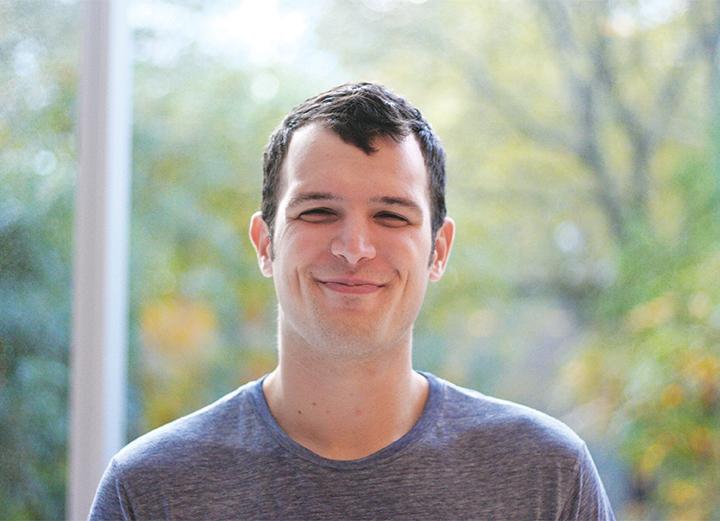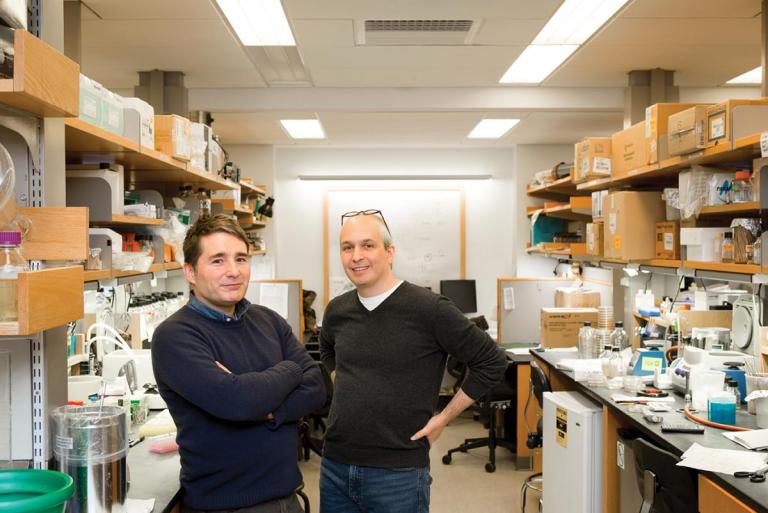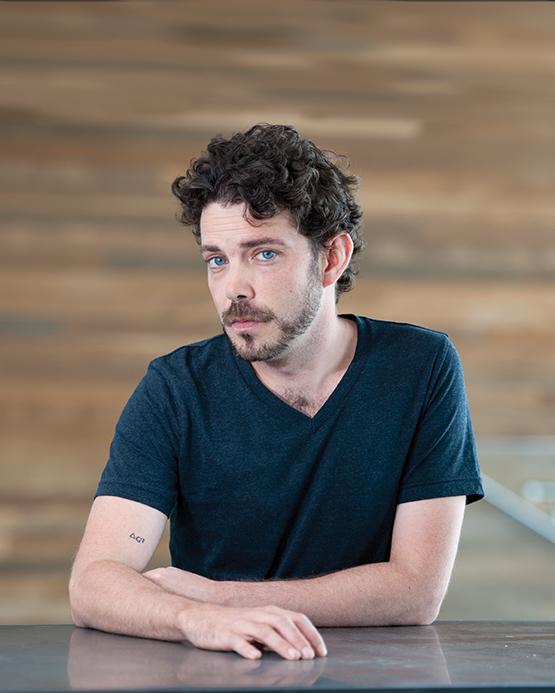It Takes a Village
Scientific inquiry requires perseverance, collaboration, and, sometimes, a bicycle
- 10 minute read
- Feature

For weeks, Alex Meeske had been pedaling to Harvard Square and back again across the Charles River, each time carrying a sample of purified protein in his backpack.
The HMS graduate student was years into his hunt for an entity those in his field called the missing polymerase. Should he identify the elusive molecular quarry, the discovery might change how researchers approach the search for new antibiotics

So Meeske shuttled samples of purified proteins between the Harvard University and HMS labs of Daniel Kahne, the Higgins Professor of Chemistry and Chemical Biology and of Molecular and Cellular Biology at Harvard and HMS professor of biological chemistry and molecular pharmacology, hoping the refined entities would present evidence that an under-the-radar set of proteins was involved in weaving the walls of worrisome rod-shaped bacteria.
For decades, the molecules that created the walls of these bacteria were thought to be a group of proteins called class A penicillin-binding proteins, so named because their presence offered penicillin a target through which it could weaken the protective outer wall of the bacteria. But there were studies that implied there might be a moonlighting enzyme that also built and shaped that cell wall, perhaps in concert with the proteins that bind penicillin.
Meeske kept up his shuttle research for nearly a half decade, working in labs on both sides of the Charles River to mine the expertise of scientists in protein biochemistry, mutation-sequencing techniques, bacterial cell-wall synthesis, and advanced microscopy. The time, patience, and collaboration paid off, however, for this trans-riverine research effort accumulated strong evidence for a possible new target for undoing infectious bacteria such as Bacillus subtilis and Escherichia coli.
Tech Support
The trail of research that preceded Meeske’s began in the 1980s with the publication of a paper, bolstered by another published in the early 2000s, that suggested another polymerase, a linked strand of proteins, was involved in the building of bacterial walls.
Meeske became involved in the research as a result of his work in the lab of David Rudner, an HMS professor of microbiology and immunobiology. Rudner is no stranger to collaboration; today he and Thomas Bernhardt, an HMS professor of microbiology and immunobiology, co-lead a research “supergroup” that combines their collective knowledge in bacterial microbiology. Rudner, Bernhardt, and former lab member Tsuyoshi Uehara shared with Meeske a deep knowledge of the history of penicillin, the love of exploring the scientific literature, and the belief that they could solve the mystery of whether class A penicillin-binding proteins were acting alone.
In Rudner’s lab, Meeske, using technical tools not available to earlier scientists, showed genetically that a protein called RodA helped shape the elongated cylindrical wall of bacteria, even when the usual wall-building suspects were knocked out. But Meeske needed more proof.
He looked to Will Robins, a postdoctoral fellow in the lab of John Mekalanos, the Adele Lehman Professor of Microbiology and Molecular Genetics at HMS, as well as to Eammon Riley, a former research assistant in the Rudner lab, for help in using a method called mutation sequencing. The trio hoped the technique would allow them to find and define the amino acids that were critical to the functioning of the RodA protein on which Meeske had focused. Finding those amino acids would bring them one step closer to knowing the RodA protein was the right target.
It’s not surprising that Meeske approached Robins for assistance. According to Bernhardt, Robins is an expert in sequencing technologies. But, Bernhardt adds, he’s also an extremely generous colleague, a “connector” who routinely helps others in the department.

Robins’ test results would provide a second verification that Meeske had isolated the RodA protein and nothing else. To help nail down the biochemistry of the protein, Rudner suggested Meeske turn to Andrew Kruse, an HMS assistant professor of biological chemistry and molecular pharmacology, for guidance on purifying the protein of interest.
Pure and Simple
Although the researchers knew RodA played a critical role in cell elongation, they had only indirect evidence that it might be a polymerase: a 1986 paper linking RodA overproduction with more cell wall synthesis in E. coli; Meeske’s data on RodA’s role in helping B. subtilis survive without the known cell-wall building proteins; and a bioinformatics connection that Meeske and others had made between RodA and a distantly related family of proteins that acted as polymerases.
What they needed was airtight evidence that RodA could catalyze cell-wall polymerization as they suspected. To get that, they needed to purify the entity and verify that it and only it was the active agent.
“It’s really the only way you can definitively show that a protein has a given activity,” explains Kruse. “I worked with Alex to develop a purification procedure that allowed him to purify it and still keep it functional.”
Sounds simple, right? Well, it’s not.
Protein purification can be painful, say Bernhardt, Rudner, and other scientists. It is, notes Rudner, where the sweat and tears come in.

Before coming to Harvard, Kruse, whose background is in membrane protein structural biology and biochemistry, had studied a major family of drug targets called G protein-coupled receptors, which pass through cell membranes seven times. Even though RodA was a very different kind of protein, the techniques that Kruse had helped develop while in the Stanford lab of Brian Kobilka, co-recipient of the 2012 Nobel Prize in Chemistry, translated well to the RodA project.
Kruse used antibody affinity chromatography for protein purification. This type of chromatography sets an extremely selective trap for a protein. Once it binds to the antibody, the protein can be washed free of the substrate of contaminants and purified. To ensure they were snaring the protein they wanted, Kruse and Meeske performed some protein engineering tricks that would flag the RodA proteins for capture.
The technique allowed Meeske to perform assays that would confirm that the enzymatic activity he had identified genetically was in fact coming from RodA alone.
“This cross-lab cooperation is representative of the way that many scientific projects work,” says Kruse. “The projects require techniques and expertise that are beyond the scope of any one lab. We’re still working with David’s lab and Tom’s lab to build on this research to understand how this protein works, but also, hopefully, to enable the development of a next generation of antibiotics.”
Gold Standard
When Ethan Garner, the John L. Loeb Associate Professor of the Natural Sciences at Harvard, first heard of Meeske’s work, he knew it would be difficult proving RodA was the gene in question. As a postdoc in Rudner’s lab, Garner had made mesmerizing movies of the mystery proteins as they formed hoops around a bacterial cell. Yet he wasn’t convinced those hoop makers were equal to the task of building a cell wall.
“I was really skeptical that RodA was the missing transglycosylase, but I hoped for the best,” Garner says. “I knew from talking to Alex at various times that nothing worked, nothing worked, nothing worked. “Then, as often happens in good science, everything crystallized in two months. Boom! I was ridiculously pleased, pleasantly surprised—amazed.”
After the protein had been successfully purified, Meeske carried it across the Charles to Kahne’s lab one more time. On the advice of Rudner, Meeske was going to talk with Suzanne Walker, an HMS professor of microbiology and immunology, about his project. Meeting with Walker was important for another reason, Bernhardt had collaborated with Walker and Kahne in the past, using synthetic enzymes they had produced.
Kahne and Walker had created the peptidoglycan building blocks that the cell-wall builders—like RodA and class A penicillin-binding proteins—need to do their jobs. Their synthetic substrate was a highly complex molecular giant that could not be bought off the shelf from chemical suppliers.
Recalls Meeske, “there are probably only two or three labs in the world that would have the peptidoglycan building blocks that Dan’s and Suzanne’s labs had.” And Meeske was about to meet with Walker.
As she learned about the project, Walker pulled out the lab notebooks compiled by a former postdoc in her lab who had recorded some thoughts on how to purify proteins such as RodA.
Walker agreed that they needed to test whether the purified RodA could, when paired with the synthetic building blocks, build a rod-shaped wall. They tried it and a rod-shaped wall appeared. They had proof that the RodA protein was a new class of bacterial cell-wall builder. They also potentially had a novel target for new antibiotics.
Cast Party
Reflecting on the years of work and the collaborations that helped make it happen, Meeske sees the project as the serendipitous result of expertise and timing.

“Membrane protein biochemistry is kind of a niche field,” says Meeske. “Having Andrew come to HMS at the moment he did was vital to the project’s completion. Having direct access to the mutation sequencing technology that allowed us to do the genetic screen and identify RodA’s importance—and to John Mekalanos and Will Robins, who pioneered the technique’s development—was another boon. And the collaboration between David and Tom was, I’d say, elemental to my research and my experience as a grad student.”
It was a mix of mentorship and collaboration, for although principal investigators such as Rudner and Bernhardt pursue discoveries, they are also lab leaders dedicated to education, to matching a particular project to a particular student. During the time Meeske was unsuccessfully attempting to purify the protein, for example, Rudner suggested Meeske take a break from the project. Meeske used that break to shake free of the project and instead consider two unrelated avenues of inquiry, each of which produced two papers for his doctoral thesis.
But the case of the missing polymerase called him back, and Kruse’s arrival injected new life into the inquiry. Then, together with Garner, they proved that RodA builds the bacterial cell walls for B. subtilis and E. coli and likely others.
Although Meeske has moved from HMS (he’s now a postdoc in the lab of Luciano Marraffini at Rockefeller University), others in the collaboration continue their probe. Garner, for instance, continues to investigate how each of the players—the class A penicillin-binding proteins and the RodA proteins—contributes to growth of the bacterial cell wall and helps shape it into a rod. Currently, it seems RodA acts to form the ribs of the ship while the class A penicillin-binding proteins fill in the rest of the hull.
Rudner and Bernhardt appreciate the decades of discoveries that their work rests upon: the 1928 discovery of penicillin by Alexander Fleming; the 1957 work by Jack Strominger, the Higgins Research Professor of Biochemistry in the stem cell and regenerative biology department, and Ted Park to describe penicillin’s molecular action; Strominger’s later work to identify penicillin-binding proteins; and work by others to show that there were likely other proteins involved in bacterial wall building. They also remain poised for new, incremental advances that are the lifeblood of basic research.
“I think what’s nice about the overall team,” says Bernhardt, “is how it has brought together a diversity of expertise. We can really attack this problem on many different levels.”
“No one planned to bring such a team together,” adds Rudner. “It happened because of the combined effect of new hires, shared meetings, and physical proximity.” By the latter, Rudner means the common lunchroom where news of equipment gets shared and research ideas get tossed around.
Institutional support also plays no small hand in the project. Kruse will continue to work with the Rudner-Bernhardt supergroup thanks to a supplement grant from one of the three Centers of Excellence for Translational Research that exist at HMS. Funded by the National Institutes of Health, the centers are designed to move discoveries closer to applications in diagnosis, treatment, and prevention of infectious disease. At HMS, the three centers are individually devoted to the study of tuberculosis, virology, and bacteriology.
“I feel more excited about this work these days than ever,” says Rudner. “It feels like we can go deeper because of the connections.”
Bernhardt agrees.
“I think that’s true with most things in science these days. You need a lot of different expertise to really get a full picture of what’s going on.”
That’s how science happens: over decades, over lunch, and sometimes, on a bike ride across a river.
Elizabeth Cooney is a Boston-based science writer.
Images: Mattias Paludi (top); Robert Heler (Meeske); John Soares (Bernhardt, Rudner, Kruse); Rick Friedman/Department of Molecular and Cellular Biology, Harvard University (Garner)